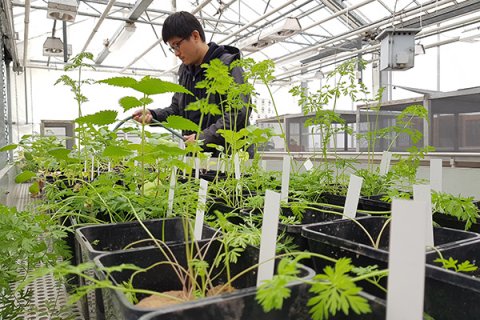Art project in Utrecht Botanic Gardens
Millenium Ginseng Project

Bio-artist Kuang-Yi Ku is currently performing an art project in the Botanic Gardens focusing on the cultivation of ginseng. “I want to design cultivated ginseng that is conceptually and culturally stronger than the wild version."
Like every week, bio-artist Kuang-Yi Ku makes his tour through the greenhouses of the Utrecht Botanic Gardens. He slides open the heavy greenhouse door and walks directly to the plants in the square black growers, which are arranged in neat rows. He looks at the growth progress of different types of plants, gives them water - or deliberately not - and looks hopefully to see if the ginseng seeds have already sprouted.
"My project is about ginseng," says Ku. “Ginseng is part of traditional Chinese medicines. It is believed that ginseng is good for health because the ginseng root is shaped like the human body and grows under difficult conditions. Consuming old, wild ginseng is especially popular because it is more powerful and prevents aging. That leads to illegal harvesting, which means that wild ginseng is threatened with extinction in some places. "
Hybrid medicine
In collaboration with scientists from Utrecht and elsewhere, Ku is now looking for a new way to grow ginseng roots that resemble the old, wild variety and can therefore be more popular than regular cultivated ginseng. “I want to design cultivated ginseng that is conceptually and culturally stronger than the wild version. The new ginseng will become a hybrid medicine, combining Western science with traditional Chinese medicine. "
That is not an easy task. Not only is it difficult to let ginseng germinate, the root also needs another seven years to mature. Reason that Botanic Gardens staff member Gerard van Buiten recommended starting with carrot and radish. Ku now tests the effect of different treatments on the shape of the root on both types; he experiments with soil type, temperature, light and water: Ku calls it the Extreme Greenhouse. “It is still work-in-progress now. Soon I will be harvesting the plants to investigate the effect of the treatments”, Ku says, rolling up the garden hose again.
In the Time Machine Farm I speed up time, which means you can have a thousand-year-old ginseng within seconds.
The Extreme Greenhouse, together with two other subprojects, forms the Millennium Ginseng Project. The Moon Ginseng and Time Machine Farm subprojects are more conceptual, Ku says. “According to a Chinese myth, ginseng might become a fairy after growing for thousand years; if someone eats this one-thousand-year old ginseng, the person might be immortal. But ginseng grows very slowly. In the Time Machine Farm I speed up time, which means you can have a thousand-year-old ginseng within seconds. Moon Ginseng is about growing ginseng on the moon. A lunar year is shorter than a year on Earth, so you only need 83 years to grow ginseng on the moon that is a thousand lunar years old."
Collaboration
In the project, Ku works together with plant scientist Rashmi Sasidharan. Her research area focuses on how plants interact with their environment. “Scientists are not always very good at explaining science and what they do to a general public. For me it was a great opportunity to bring my science to the public through a more creative outlet”, says Sasidharan in this video that Ku made about the project. Ku receives practical support during the planting from hortus employee Gerard van Buiten. "We also try to grow ginseng in the garden and for us it's a very difficult plant to grow. So I am interested as a gardener how to grow ginseng in our climate zone”, he says in the video.
Kuang-Yi Ku exhibited the Millenium Ginseng Project earlier this year at TAC Eindhoven, exhibits in November at the Taipei Digital Art Festival in Taiwan and possibly during the Dutch Design Week.

